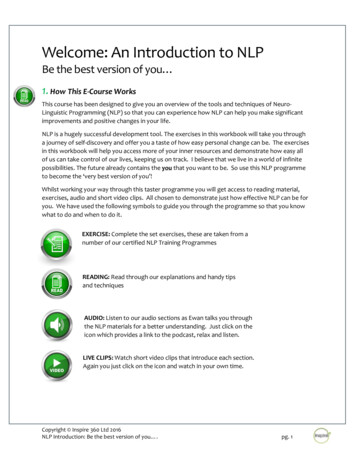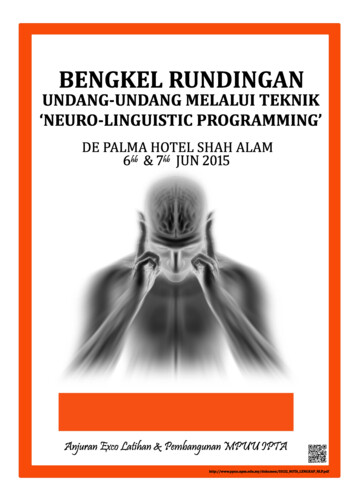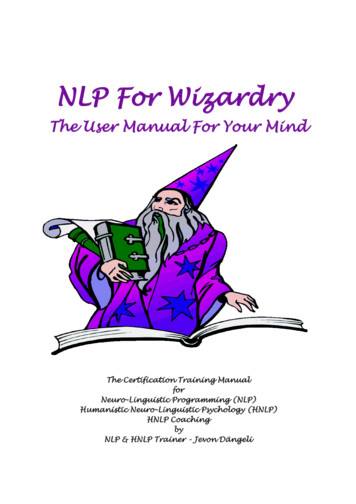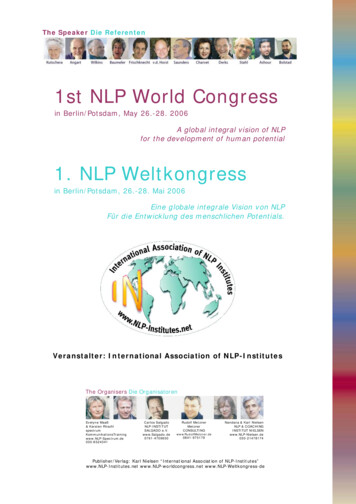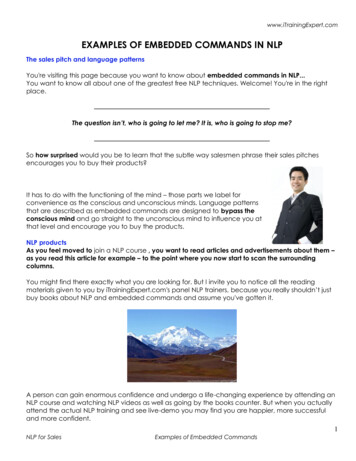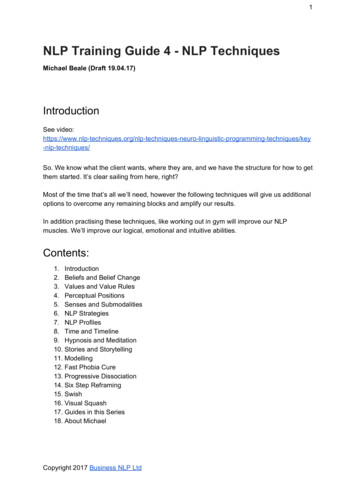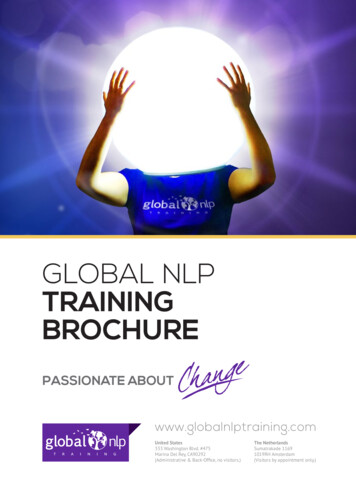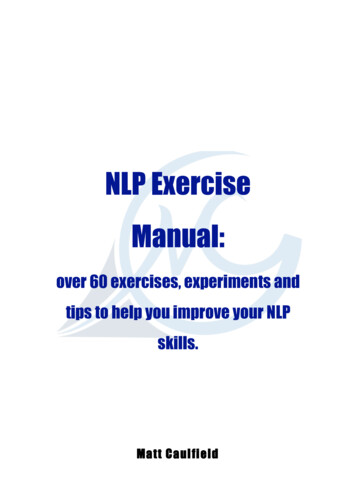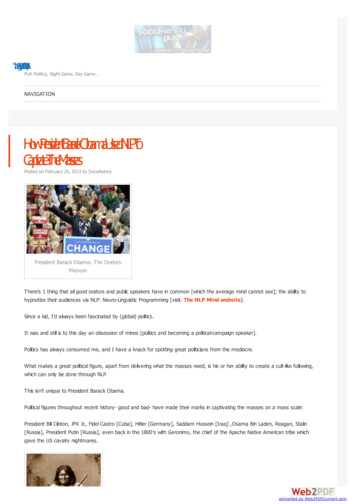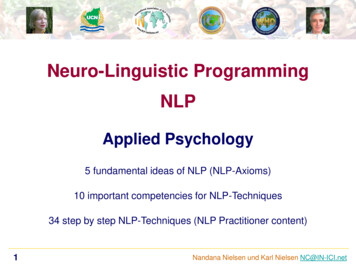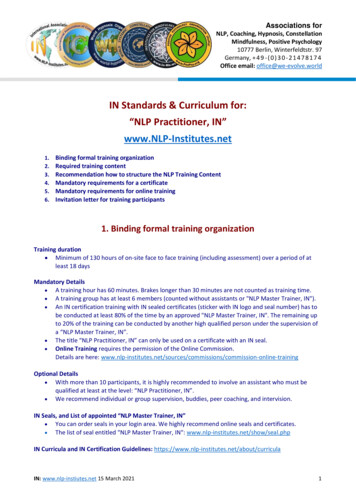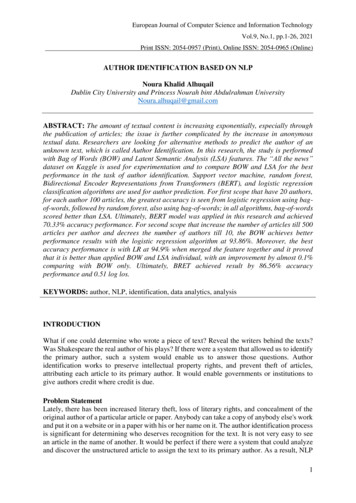
Transcription
European Journal of Computer Science and Information TechnologyVol.9, No.1, pp.1-26, 2021Print ISSN: 2054-0957 (Print), Online ISSN: 2054-0965 (Online)AUTHOR IDENTIFICATION BASED ON NLPNoura Khalid AlhuqailDublin City University and Princess Nourah bint Abdulrahman UniversityNoura.alhuqail@gmail.comABSTRACT: The amount of textual content is increasing exponentially, especially throughthe publication of articles; the issue is further complicated by the increase in anonymoustextual data. Researchers are looking for alternative methods to predict the author of anunknown text, which is called Author Identification. In this research, the study is performedwith Bag of Words (BOW) and Latent Semantic Analysis (LSA) features. The “All the news”dataset on Kaggle is used for experimentation and to compare BOW and LSA for the bestperformance in the task of author identification. Support vector machine, random forest,Bidirectional Encoder Representations from Transformers (BERT), and logistic regressionclassification algorithms are used for author prediction. For first scope that have 20 authors,for each author 100 articles, the greatest accuracy is seen from logistic regression using bagof-words, followed by random forest, also using bag-of-words; in all algorithms, bag-of-wordsscored better than LSA. Ultimately, BERT model was applied in this research and achieved70.33% accuracy performance. For second scope that increase the number of articles till 500articles per author and decrees the number of authors till 10, the BOW achieves betterperformance results with the logistic regression algorithm at 93.86%. Moreover, the bestaccuracy performance is with LR at 94.9% when merged the feature together and it provedthat it is better than applied BOW and LSA individual, with an improvement by almost 0.1%comparing with BOW only. Ultimately, BRET achieved result by 86.56% accuracyperformance and 0.51 log los.KEYWORDS: author, NLP, identification, data analytics, analysisINTRODUCTIONWhat if one could determine who wrote a piece of text? Reveal the writers behind the texts?Was Shakespeare the real author of his plays? If there were a system that allowed us to identifythe primary author, such a system would enable us to answer those questions. Authoridentification works to preserve intellectual property rights, and prevent theft of articles,attributing each article to its primary author. It would enable governments or institutions togive authors credit where credit is due.Problem StatementLately, there has been increased literary theft, loss of literary rights, and concealment of theoriginal author of a particular article or paper. Anybody can take a copy of anybody else's workand put it on a website or in a paper with his or her name on it. The author identification processis significant for determining who deserves recognition for the text. It is not very easy to seean article in the name of another. It would be perfect if there were a system that could analyzeand discover the unstructured article to assign the text to its primary author. As a result, NLP1
European Journal of Computer Science and Information TechnologyVol.9, No.1, pp.1-26, 2021Print ISSN: 2054-0957 (Print), Online ISSN: 2054-0965 (Online)analysis has emerged to analyze articles and extract features to predict author name. This studywill focus on NLP analysis of given articles and how the NLP, based on machine learningalgorithms, will help to predict the author’s name.Research QuestionsThe research will answer the following questions:o How can the models predict the author's name from a published article?o Which model of feature generation, between Bag-of-Words (BOW) and LatentSemantic Analysis (LSA), performs the best for the task of author identification?Aims and ObjectivesThe aims and objectives of this study are as follows:o Predicting the author’s name from a given article.o Comparing BOW and LSA, to find which performs best for the task of authoridentification.o Using different classifier models to predict the author's name.o Comparing the performance of multiple classifiers.Scope of the studyThe search scope is as follows:o The research concentrates on studying author identification analysis based on NLP forpublished articles.o The scope is for twenty authors in two newspapers.o The research concentrates on English articles only.LITERATURE REVIEWNatural Language Processing (NLP)Natural Language Processing is the method used to aid machines to understand human naturallanguage. It is a section of artificial intelligence that deals with the interaction betweenmachines and humans using natural language. NLP aims to read, decode, analyze, understand,and make sense of human languages to derive meaning. Authorship identification is anessential topic in the field of NLP. It enables us to identify the most likely writer of articles,news, text, or messages. Authorship identification can be used to identify anonymous writersor detect plagiarism.Authorship analysisAuthorship analysis is a challenging field that has evolved over the years. It is the procedureof finding the characteristics of a text in order to draw conclusions and analyze its authorship.Stylometry is the root of authorship analysis, which means the statistical way to analyze thetext style in order to characterize the author. The concept of authorship analysis can be definedand divided into three sections as follows:o Authorship identification (authorship attribution): Finding the real writers of an articleor document and the possibility of an author having written some text.o Author profiling (characterization): getting the writer’s profile or characteristics; forexample, gender, age, background, and language.o Similarity detection: Finding the similarity between the texts to determine thepossibility of them having been produced by a single writer, without necessarily findingthe real author. Commonly used in plagiarism detection.2
European Journal of Computer Science and Information TechnologyVol.9, No.1, pp.1-26, 2021Print ISSN: 2054-0957 (Print), Online ISSN: 2054-0965 (Online)Data gatheringThe authorship identification dataset includes varied sources of previous work, includingbooks, scientific papers, articles, and even emails. Still, ultimately, the focus was on the textregardless of its type.PAN dataset: In studies [1] [2], the dataset comprised documents from the PAN competitiondataset for Authorship Attribution. It is a publicly available dataset, focused on Authorshipanalysis. The author analysis in [3] was carried out by using the same dataset. They focus onauthor multi-genre and multi-language problems. It has a combination of genres, like essays,novels, articles in Spanish, English and Greek, and the total number of documents is 7,044.Two datasets were used in [4] The first is PAN 2012; the second is the Urdu articles dataset,which has 4,800 articles written in twelve well-known Urdu newspapers, with 400 articles byeach author.Reuter dataset: Study [5] worked on two different datasets. One is the Reuters news dataset,which is widely using for authorship identification; it is an archive of over 800,000 newswirestories. The second dataset is the Gutenberg dataset that was established by the author,containing 53,000 e-books on the Internet. Study [6] wrote that they used a subset of the Reutersdataset, including 50 authors, who have each written 100 articles. Study [7] used 21 Englishbooks, written by ten different authors, as well as a collection of news stories from the Reutersdataset. Likewise, the dataset used in [8] was based on the Reuters dataset; they chose allauthors who had 200 or more articles. The collected dataset contained 114 authors who wrote27,342 articles in total. Two types of text corpora have been used in [9]; one in English, theReuters newswire stories dataset; and the other in Arabic (newspaper reportage from Al-Hayatwebsite). Both contain different authors, with 100 texts for each author. The Reuter 50 50Dataset was applied in [10]; it contains 50 authors and 50 texts per author.Articles: In study [11] the dataset was manually gathered from several Arabic websites. Thedataset consists of 10 authors, with 10 articles for each author, while [12] developed a datasetcontaining text from different newspapers. The topics of these articles are about current events,political and medical issues. There are 20 authors, with 20 texts for each author in the trainingset, while, for the test set, there are 20 authors with five different texts for each. In [13], theresearch consists of approximately 145 student essays of about 1400 words for each essays.The essays are a real description of the Artificial Life documentary and the students’ opinionsabout it. Thereby the topic, age, and level of education are constant. In study [14], the datasetcontains 20 different authors who write about Economics, Sports, Literature, and miscellaneoussubjects. The articles were obtained from two Brazilian publications. Each writer has 30 pieces.Work [15] is based on thirteen selected Nigerian writers from a Nigerian national daily. Theyharvested articles published from 2014 to 2016, and collected a total of 20 articles per author,so the total is 260 articles.Papers: Study [16] used the ACL anthology network corpus dataset, which contains 23,766papers and 18,862 authors. Also in the field of scientific papers, [17] used ACL papers. Thedataset includes scientific papers published in several conferences and workshops. The selectedpapers were from 1965 to 2007; they classified all 2006 papers as development data and all2007 papers as test data and the remaining papers were used for the training set.Emails: In [18] [19] [20] a real-life dataset was obtained from the email records of Enron,which is an energy company. The employees’ emails were made public, and the dataset3
European Journal of Computer Science and Information TechnologyVol.9, No.1, pp.1-26, 2021Print ISSN: 2054-0957 (Print), Online ISSN: 2054-0965 (Online)contains approximately 200 thousand emails from about 150 employees. The average wordcount per email is 200. The emails are simple texts and cover several topics ranging frombusiness connection to technical reports and personal conversations.Other data types: In [21], the authors gathered a collection of 23 novels. They selected six ofthem as the experimental dataset. There are approximately 22,000 texts. For each author, theyselected text from random novels to ensure they were cross-topic.The method of collecting datain [22] was different: the author relied on only two books, and each book was divided into partsand saved in different files. Testing can be executed with various training sets from the bookchapters of both authors then different book chapters by the same author are tested to determinethe accuracy of the prediction. In [23], the author collects six types of text in different languages(Dutch, English, Greek, and Spanish), and genres (essays, reviews, novels, and articles ). AGreek blogs dataset was created in [24] from scratch.They manually collected 100 Greekauthors' blogs. In their study, they used 20 blogs with a common topic of personal affairs. Thetotal is 1,000 blog posts with a total of 406,460 words. For each author, they collected 50 recentblogs. In [25], the writer collected online messages for Cyber Forensics Analysis. Themessages were written by the author who tried to hide their real identity to void detection.Random Forest: Pre-processing is a significant step in text mining. It means turning the textinto a form that is predictable and analyzable. In [1], the pre-processing was divided into twotypes of features, depending on the requirement of the model. In the Bag of Words model forextracting content-based features, the author applied stop word removal and stemming, thenextract the most frequent specific terms and consider them as a bag of words. The Bag of Wordsmodel is used for extracting n-gram features that tend to appear in the author's writing styleand can be used to compare the writing style of one author to another, Therefore, as the firststep, the author removes punctuation marks and extracts the most frequent character n-grams,word n-grams, and POS n-grams. Once the dataset is prepared and pre-process works done,feature extraction is needed to convert the data to vectors. In this step, the author uses the bagof words to represent the data vector, then uses classification algorithms; specifically, the NaiveBayes Multinomial (NBM) and Random Forest (RF). The author compares predictions withthe most frequent content-based features with the accuracies of the most frequent character,word, and POS n-grams. The best results of author prediction are achieved when the authoruses a combination of content-based features and n-grams, using the Random Forest classifieralgorithm, with 91.87% accuracy. [3], on the other hand, evaluates the extracted features unigram features, Latent semantic features, and similarity - by producing a supervised machinelearning algorithm comparing Logistic regression, Random Forest, and SVM. The RandomForest tree produces higher performance than other models. with accuracy of up to 80.12%.Support vector machine: Some authors, like [11], did not do any pre-processing work. Intheir view, the reason for this is to keep the text as it is to indicate the unique writing style ofeach author. Moreover, they classify and rank tasks and use SVM-Light, which is an opensource tool common in the machine learning community, with an interface to train and test amodel. The author extracts the features and bundles them into five groups: F1: lexical; F2:lexical and syntactic; F3: lexical, syntactic, content-specific; F4: lexical, syntactic, contentspecific, structural; and F5: lexical, syntactic, content-specific, structural, and semantic. Theytest all five groups of features, and the accuracy calculated as a total can correctly identify theauthor of an article from the test sample. The accuracy performance of this bundle of featureset is successively; F1: 88%; F1 F2: 92%; F1 F2 F3: 95%; F1 F2 F3 F4: 96%; and4
European Journal of Computer Science and Information TechnologyVol.9, No.1, pp.1-26, 2021Print ISSN: 2054-0957 (Print), Online ISSN: 2054-0965 (Online)F1 F2 F3 F4 F5: 98%. In [21], on the other hand, the authors focused on four essentialfeatures, which are:1. Character-based features used to clarify the style of writing. For example, if there aremany commas, then the author is more formal, and if there are many questions, theauthor is more emotional.2. Word-based features commonly used in author identification, referring to wordstatistics information, rather than using words directly. In addition, the word-basedfeatures analysis applies the standard deviation of the word length; average wordlength; the difference between the maximum word length and the minimum wordlength.3. Sentence-based features, fundamental to describing the construction of the text orarticle. Different authors use different constructions to write their articles. Someauthors’ styles are simple, so the sentences in their articles are possibly shorter, whileother authors possibly prefer long sentences. The author of this study used the meanlength of sentences, the standard deviation of sentence length, and the differencebetween the maximum and minimum values of the sentence length.4. Syntactic features which are analyzed by syntactic analysis tools. Syntactic featuresrefer to the grammatical relationship between words in sentences. Therefore, they usea support vector machine (SVM) and a linear kernel. They use the tools released byHIT: pylyp function for the segments of Words and parts-of-speech. They use two typesof performance measurement; accuracy and PRF scores. They show that the accuracyand the f1-score of using the syntactic features alone rises about 12%, indicating theefficiency of using syntactic features alone, rather than other essential features. Theauthor concluded that using syntactic features alone reduced the size of the feature setto decrease the computational overhead, and showed the high possibility of the syntaxtree for author identification.In study [7], the text was analyzed in several ways: tokenizing, part-of-speech tagging, phraseparsing, and typed dependency parsing. Then they identified pronouns, function words andnon-subject stylistic words. Therefore, they used k-nearest neighbors (KNN), support vectormachine (SVM), and latent Dirichlet allocation (LDA) and made comparisons between theperformance of different selected feature sets. They used the LIBSVM package for SVM. anda fivefold cross-validation way to select it from the candidate dataset. The core approach is acollection of n-gram features and SVM, excluding PCA feature extraction, and n is a positiveinteger. The LDA achieves higher performance by 98.45%.In [24], a Greek blogs dataset used a set of stylometric features. The features include classicstylometric features, such as lexical, word length measures, and features extracted from ngrams. They use the extracted features and the Support Vector Machines algorithm to reach85.4% accuracy in authorship attribution. The feed-forward neural network was used in [25],with a radial basis function network, and Support Vector Machines applied to predict theauthorship of anonymous online text. They begin by extracting features for each unstructuredtext, which appear as a vector of writing-style features.Study [26] investigated authorship identification of Telugu text by using several features:average number of words, sentences, syllables per word, word length, sentence length, parts ofspeech, bigrams and trigrams of the word. They used a support vector machine classifier for5
European Journal of Computer Science and Information TechnologyVol.9, No.1, pp.1-26, 2021Print ISSN: 2054-0957 (Print), Online ISSN: 2054-0965 (Online)feature vectors. The accuracy performance of the SVM model for authorship identification wasmeasured, and the results showed that character n-gram features occurred at a higher rate thanall other features. The combination of several features, like word grams mixed with lexical andvocabulary features, reached a higher rate than applying the features separately.In [15], the authors performed experiments, applying five different subsets of the mainattributes by using a rough mechanism. The results of the experiment showed that using a roughset mechanism improved the accuracy performances for both neural network algorithms andthe Supported Vector Machines algorithm. The classification model accuracy increased to50.505% for the NN and 28.662% for the SVM algorithm. However, the NN algorithmperformed better than the SVM algorithm.In [10], the author introduces the Stylometry approach and n-gram features for the authorshipidentification task. They achieved 85% performance accuracy for the SVM classifier model. In[27], the authors suggested using a support vector machine model for heterogeneousdocuments. Moreover, experimental results showed that applying both n-grams and sequentialword patterns together achieved better accuracy performance than n-grams alone.Latent semantic analysis: In [23], the author focused on representing the writing style of theauthors; they used lexical-syntactic features. The work is divided into two levels; the first oneis Phrase-level features: Word prefixes, Word suffixes, stop words, Punctuation marks, Wordn-grams and Skip-grams; the second one is Character-level features: Vowel combination andVowel permutation. The reason for using lexical-syntactic features is due to the ease ofidentification. The writer treated them with unsupervised classification, using several metricsto determine the similarity of the feature vectors of the documents of the known author againstthe documents of the unknown author. To establish the similarity of the documents, they usedLatent semantic analysis (LSA), Jaccard similarity, Euclidean distance, Cosine similarity andChebyshev Distance.In [2], they create n-grams by sliding a window along the document to use as the features forthe Document matrix. Thus, they develop an effective LSA by the use of character n-grambased analysis. In terms of accuracy, the percentage reached 75.68% for Dutch reviews in thePAN dataset.Cosine similarity: In [16], the authors used the n-gram frequency technique and reflectedunigram, bigram, and trigram technique and implement stop-word removal, then used thePython NLTK package for Porter Stemming. There are two kinds of features extracted tocharacterize the paper or the author. They apply LINE heterogeneous network embeddingadapted to suit author identification. They apply the trained model by taking both the inputpaper embedding vectors and the author embedding vector and then create embedding for thetest papers of the anonymous author. They compare the embedding of the trained author vectorswith the test paper embedding results. They use cosine similarity over the embedding vectorvalues to assess the distance between a potential author and the test paper, with the accuracyof results reaching 66.66%.In [4], the author decided that there was no need for robust pre-processing in authorshipattribution. Spelling errors, letter abbreviations, and letter capitalization are an essential part ofwriting style, so they decided not to fix grammatical errors or word stems; such actions mayreduce the number of features for a writer. Nevertheless, they carried out the following fordocument pre-processing: tokenization, lowercasing, n-gram generation, and stop-wordremoval. For syntax analysis and feature extraction, they carried out TF-IDF and bag-of-words6
European Journal of Computer Science and Information TechnologyVol.9, No.1, pp.1-26, 2021Print ISSN: 2054-0957 (Print), Online ISSN: 2054-0965 (Online)extraction. The LDA approach is focused on instance-based and profile-based classificationsof author identification. LDA is an unsupervised methodology that can handle a variety ofwriting, high-dimensional and sparse datasets by allowing more text. The author used cosinesimilarity alongside n-gram-based LDA to measure similarity in vectors of text. They achievedoverall 84.52% accuracy in the first dataset and 93.17% accuracy on the second dataset withoutapplied any labels to identify author tasks.Bayesian Classifier: In [22], they extracted lexical features, such as the number of words,statistical information, and syntactic features for classification. These are essential featuresbecause different authors mean a different level of vocabulary. The vocabulary level of theauthor can be decided by the total number of single words they use in the text. Although thedataset is small, the predictive accuracy performance, which is measured by using k-fold crossvalidation, is low when using the Bayesian Classifier. They proved that the accuracy decreasesif the dataset volume decreases. Also, as the data volume decreases, the uncertainty of theactual predictive accuracy increases; the results from a small dataset will not be as accurate asof the large dataset. In [8], the author used Bayesian multinomial logistic regression to buildclassifiers on various data sets.N-gram: While classical documents are very well structured and provide various stylometricfeatures, an e-mail [18] consists of a few paragraphs, written by an employee quickly, andfrequently with syntactic and grammatical mistakes. All the sample e-mails are divided intogroups to build a given author profile into one document that is subsequently divided into smallblocks. They applied these processes: replace all numbers with 0; normalize the emails toprintable ASCII; converted the emails to lowercase characters; remove white space; removeany punctuation; group all emails by author, to make a document that is divided into blocks.In the Enron email dataset, the Equal Error Rate (EER) was14.35% for 87 employees for smallblock sizes. While the acquired results are hopeful, the author decides that more effort must bemade to be usable in the real world. They discussed the limitations of their approach. Theaccuracy decreased, not only when the number of authors number increased, but also when thenumber of blocks per employee decreased. They applied 5-grams that achieve better resultsthan 3- and 4-grams for a large number of blocks per user.However, in [28], pre-processing was required to produce the character n-gram profile. Theauthor removed numerals from the text, eliminated all punctuation marks, partitioned the textinto separate tokens, locating all possible n-gram for N 2, 3, then making sure that each outputn-gram in the list has its frequency, sorting the n-gram frequencies in descending order, andfor each author, they build a profile size for bi-grams, tri-grams and quad-grams. The authorscreate the bi- & tri-grams from the author’s text called Author’s Profile. n-gram was used tocalculate the dissimilarity between the frequency of the n-gram in the Author’s Profile and thefrequency in the test data.Other methods: The pre-processing in [5] primarily consists of two parts. The first one is wordrepresentations, where the authors used the GloVe word vectors to initialize the wordembeddings and excluded the occurrences of numbers and special characters to match thefeatures of the word representations. During the pre-process, the author trimmed each word toensure that it did not include any number or special character. The second technique is InputBatch Alignment; there is a fixed-length batch as input, with the input truncated if it exceedsthe fixed length. If there are words that cannot be found in the GloVe, they are replaced by amagic word that is created by the author; it is a word that does not exist in the real world. The7
European Journal of Computer Science and Information TechnologyVol.9, No.1, pp.1-26, 2021Print ISSN: 2054-0957 (Print), Online ISSN: 2054-0965 (Online)magic word was hidden to remove its effect on the output and only the actual words wereextracted. They implemented four authorship identification deep learning models. The best twowere: Article-level GRU, which achieved 69% on the Reuters news dataset and 89% on theGutenberg dataset; and the Siamese network, which performed with 99.8% accuracy on boththe C50 and Gutenberg datasets.The author of [6] suggested randomly partitioning the dataset into three groups: 60% for thetraining set and the validation set, with 10% of the dataset and applied hyperparameters tochoose the best order, and finally they used 30% of the dataset for evaluating the classificationperformance test set. They applied deep learning for author identification, and they comparedthe performance between the features extracted. The author showed that the chi-square-basedfeature produced a high performance compared to frequency-based features. To produce a highaccuracy, the author applied min-max normalization. 95.12% is the systematic classificationaccuracy.In the ACL papers dataset [17], they ignore the first ten lines of each paper document in orderto exclude author names, publications, emails, and business information. For authorshipidentification prediction, they used a convolutional neural network (CNN). Each sentenceappears as a padded series of word embedding vectors and POS-tag one-hot encodings. Theyproved that extraordinary words support system performance. They achieved 95% accurateperformances on the training dataset.[12] studied 35 style markers for an average of 20 articles of each author in the training set.For stemming words, they used the Turkish NLP library, Zemberek, which is a Turkish NaturalLanguage Processing system, to identify 35 style markers; with this model, they achieved anaccuracy of 70.75%. Then they selected 22 style markers, which were the most effective ones.They obtained the best success with Naive Bayes Multinomial, that was 80% after attributeswere extracted using the CFS Evaluator with the Search of the Rank method.In [9], the author decided not to perform pre-processing of texts for the dataset, apart fromdeleting XML and HTML labels irrelevant to the text content. The author represents fourmethods. The first is under-sampling of the classes, based on the training set; the secondmethod is under-sampling of the classes, based on training set lines; the third method is rebalancing the set by document samples of variable length; the fourth method is re-balancingthe set by document re-sampling.In [14], they discuss applying compression algorithms for authorship identification. They applythree types of compressors: statistical type, Lempel-Ziv type, and block-sorting type. TheNormalized Compression Distance (NCD) and Conditional Complexity of Compression(CCC) were applied to compute the dissimilarity between two documents. For the instancebased approach, NCD is suitable, while CCC gives better results when used with the profilebased approach.In [29], the naive Bayes classifier was shown to be unusable in author identification, despitethe simplicity of the model, but the author applied naive Bayes and proposed two types offeature selection process, based first on a univariate feature extraction and then featureclustering. They prove the effectiveness of their method by evaluating and comparing 13datasets. The performance refinement thus achieved makes the proposed algorithm comparablewith other classifiers.8
European Journal of Computer Science and Information TechnologyVol.9, No.1, pp.1-26, 2021Print ISSN: 2054-0957 (Print), Online ISSN: 2054-0965 (Online)In study [19], the author applied a model for email authorship identification by using a Clusterbased Classification (CCM) technique. Stylometric features were used, which were extendedto get more useful features for email authorship identification. In addition, they used Info Gainfeaturing extraction-based content features. There was a positive impact on the accuracy byusing these fe
Natural Language Processing is the method used to aid machines to understand human natural language. It is a section of artificial intelligence that deals with the interaction between machines and humans using natural language. NLP aims to read, decode, analyze, understand, and make sense of human languages to derive meaning. .

